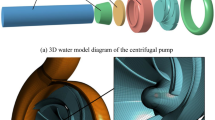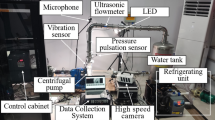Abstract
This study extracted cavitation pulses from hydrophone signals sampled in a centrifugal pump and analyzed their characteristics. The modified and simplified Empirical mode decomposition (EMD) algorithm was proposed for extracting cavitation pulses from strong background noise. Experimental results showed that EMD can effectively suppress noise and obtain clear cavitation pulses, facilitating the identification of the number of pulses associated with the degree of cavitation. The cavitation characteristics were modeled to predict the value of incipient cavitation. Then, we proposed a method for detecting the wear of the impeller surface. That is, the information on the impeller surface of the centrifugal pump, including the roughness of the impeller surface and its wear trends, were quantified based on the net positive suction head available of incipient cavitation. The findings indicate that the proposed technique is suitable for condition monitoring of the pump.
Similar content being viewed by others
References
L. Alfayez, D. Mba and G. Dyson, The application of acoustic emission for detecting incipient cavitation and the best efficiency point of a 60 kW centrifugal pump: case study, Ndt & E International, 38 (5) (2005) 354–358.
T. Rus et al., An investigation of the relationship between acoustic emission, vibration, noise and cavitation structures on a Kaplan turbine, Journal of Fluids Engineering, 129 (9) (2007) 1112–1122.
P. Bourdon et al., Hydro turbine profitability and cavitation erosion, Waterpower Conference (2014) 1–10.
E. Jantunen, H. Jokinen and R. Milne, Flexible expert system for automated on-line diagnosis of tool condition, DTIC Dacument (1996).
Z. Pu, W. Zhang and K. Shi, Design of on-line monitoring system of turbine cavitation, Automation of Electric Power Systems (2004).
Y. Ni et al., Detection of cavitation in centrifugal pump by vibration methods, Chinese Journal of Mechanical Engineering, 21 (5) (2008) 46–49.
Z. Yan et al., Fluid cavitation detection method with phase demodulation of ultrasonic signal, Applied Acoustics, 87 (2015) 198–204.
P. A. Abbot, J. Walsh and R. Halas, Cavitation noise investigation of a pump-turbine, Waterpower ASCE (2015) 2031–2040.
Y. Lei et al., A review on empirical mode decomposition in fault diagnosis of rotating machinery, Mechanical Systems & Signal Processing, 35 (1-2) (2013) 108–126.
S. A. Al-Hashmi, Spectrum analysis of acoustic signals for cavitation detection, Industrial Electronics and Applications IEEE (2012) 321–325.
X. Escaler et al., Detection of cavitation in hydraulic turbines, Mechanical Systems & Signal Processing, 20 (4) (2006) 983–1007.
Z. Zhu, Characteristic correlation between propellers cavitating wake and cavitation noise, Applied Acoustics, 81 (14) (2014) 31–39.
P. Simard and E. L. Tavernier, Fractal approach for signal processing and application to the diagnosis of cavitation, Mechanical Systems & Signal Processing, 14 (3) (2000) 459–469.
P. U. Zhong-Qi et al., Research on turbine cavitation testing based on wavelet singularity detection, Proceedings of the CSEE, 25 (8) (2005) 105–109.
D. Ross and W. A. Kuperman, Mechanics of underwater noise, Journal of the Acoustical Society of America, 86 (4) (1989) 1626.
J. G. Lourens and J. A. D. Prcez, Passive sonar ML estimator for ship propeller speed, Communications and Signal Processing, COMSIG '97. Proceedings of the 1997 South African Symposium on (1997) 13–18.
R. Rajagopal, B. Sankaranarayanan and P. Ramakrishna Rao, Target classification in a passive sonar-an expert system approach, IEEE International Conference on Acoustics, Speech, & Signal Processing, 5 (1990) 2911–2914.
M. Cdina, Detection of cavitation phenomenon in a centrifugal pump using audible sound, Mechanical Systems & Signal Processing, 17 (6) (2003) 1335–1347.
L. I. Jing et al., Feature extraction of turbine cavitation based on wavelet packet and fractal analysis, Water Power (2013).
F. A. Alturki, A. Abouel-Kasem and S. M. Ahmed, Characteristics of cavitation erosion using image processing techniques, Journal of Tribology, 135 (1) (2012).
C. F. Caskey, D. Kruse and K. W. Ferrara, A cavitation detector for microbubble therapy based on the Stockwell transform, Journal of the Acoustical Society of America, 134 (5) (2013) 3976.
G. Z. Shi and J. C. Hu, Ship noise demodulation line spectrum fusion feature extraction based on the wavelet packet, International Conference on Wavelet Analysis and Pattern Recognition (2007) 846–850.
N. E. Huang et al., The empirical mode decomposition and the hilbert spectrum for nonlinear and non-stationary time series analysis, Proceedings of the Royal Society A Mathematical Physical & Engineering Sciences, 454 (1971) (1998) 903–995.
Y. G. Xue and H. Wang, Investigation on turbine cavitation signals analysis based on Hilbert-Huang transform, Journal of Xi'an University of Technology (2010).
F. Bao et al., EMD-based extraction of modulated cavitation noise ?, Mechanical Systems & Signal Processing, 24 (7) (2010) 2124–2136.
Y. L. Zhou and C. Liang, Research on fault diagnosis of cavitation for centrifugal pump based on energy entropy of EMD, Control & Instruments in Chemical Industry (2010).
A. M. Ren et al., Detection of cavitation characteristics with demodulation technique based on EMD and Hilbert transform, Journal of Naval University of Engineering (2014).
G. Rilling, P. Flandrin and P. Goncalves, On empirical mode decomposition and its algorithms, Proc. IEEEEURASIP Workshop on Nonlinear Signal and Image Processing NSIP-03, Grado, I (3) (2003).
R. T. Rato, M. D. Ortigueira and A. G. Batista, On the HHT, its problems, and some solutions, Mechanical Systems & Signal Processing, 22 (6) (2008) 1374–1394.
G. Chen and Z. Wang, A signal decomposition theorem with Hilbert transform and its application to narrowband time series with closely spaced frequency components, Mechanical Systems & Signal Processing, 28 (2) (2012) 258–279.
Z. Wu and N. E. Huang, Ensemble empirical mode decomposition: a noise-assisted data analysis method, Advances in Adaptive Data Analysis, 1 (1) (2011) 1–41.
Y. Lei, Z. He and Y. Zi, Application of the EEMD method to rotor fault diagnosis of rotating machinery, Mechanical Systems & Signal Processing, 23 (4) (2009) 1327–1338.
Y. Su, Cavitation experimental research on centrifugal pump, Transactions of the Chinese Society for Agricultural Machinery (2010).
M. Rusticucci et al., A survey and new measurements of ice vapor pressure at temperatures between 170 and 250K, Geophysical Research Letters (American Geophysical Union), United States, 20 (5.5) (1993) 363–366.
IEC, International Standard IEC 60193: Hydraulic Turbines, Storage Pumps and Pump-Turbines—Model Acceptance Tests, 2nd ed., The International Electrotechnical Commission, Geneva, Switzerland (1999).
Y. Su, Cavitation experimental research on centrifugal pump, Transactions of the Chinese Society for Agricultural Machinery (2010).
ANSYS Inc, FLUENT 6.3 user guide, Pennsylvania: ANSYS Inc. (2006).
Siemens Product Lifecycle Management Software Inc, NX 5.0.6 What’s New Guide, Siemens Inc. (2009).
ANSYS Inc, ANSYS ICEM CFD Brochure, USA: ANSYS Inc. (2010).
V. Yakhot and S. A. Orszag, Renormalization group analysis of turbulence. I. Basic theory, Journal of Scientific Computing, 1 (1)(1986) 3–51.
L. M. Smith and S. L. Woodruff, Renormalization-group analysis of turbulence, Annual Review of Fluid Mechanics, 30 (1) (1998) 275–310.
A. Baddeley et al., Components of fluent reading, Journal of Memory & Language, 24 (1) (1985) 119–131.
S. Schmidt and F. Thiele, Comparison of numerical methods applied to the flow over wall-mounted cubes, International Journal of Heat & Fluid Flow, 23 (3) (2002) 330–339.
V. Michelassi, Direct numerical simulation, large eddy simulation and unsteady Reynolds-averaged Navier—Stokes simulations of periodic unsteady flow in a low-pressure turbine cascade: A comparison, Proceedings of the Institution of Mechanical Engineers Part A Journal of Power & Energy, 217 (2003) 403–411.
E. Johnsen et al., Assessment of high-resolution methods for numerical simulations of compressible turbulence with shock waves, Journal of Computational Physics, 229 (4) (2010) 1213–1237.
Y. Wang et al., Natural cavitation in high speed water entry process, MEMS-12 (2012).
H. Li et al., Advanced computational modeling of steady and unsteady cavitating flows, ASME 2008 International Mechanical Engineering Congress and Exposition (2008) 413–423.
I. S. Pearsall, Paper 14: Acoustic detection of cavitation, SAGE Publications (1966) 1–8.
S. Gopalakrishnan, Modern cavitation criteria for centrifugal pumps, Proceeding of the Second International Pump Symposium (1985).
Author information
Authors and Affiliations
Corresponding author
Additional information
Recommended by Associate Editor Weon Gyu Shin
Hong Li, Ph.D., is a Lecturer employed by the School of Automation Engineering, University of Electronic Science and Technology of China. He majors in signal detection and analysis.
Rights and permissions
About this article
Cite this article
Li, H., Yu, B., Qing, B. et al. Cavitation pulse extraction and centrifugal pump analysis. J Mech Sci Technol 31, 1181–1188 (2017). https://doi.org/10.1007/s12206-017-0216-z
Received:
Revised:
Accepted:
Published:
Issue Date:
DOI: https://doi.org/10.1007/s12206-017-0216-z




